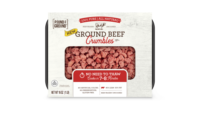Ground Beef Gets a Boost
By Richard Mitchell,
Editor, Meat and Deli Retailer
Editor, Meat and Deli Retailer
The launch of new fresh and frozen varieties are adding to ground beef’s allure.
Ground beef has reigned as one of the meat case’s perennially popular attractions. Bolstered by its position as an easy-to-prepare and flavorful entrée and ingredient, grind shipments have remained solid in spite of enhanced competition from chicken and other proteins, and higher overall beef prices.
FreshLook Marketing, a Hoffman Estates, Ill.-based research firm, reports that U.S. dollar sales of ground beef totaled $14.86 billion in 2005, up from $14.41 billion in 2004 and $13.6 billion in 2003.
A 2004 study from The NPD Group Inc., a Port Washington, N.Y.-based consumer research firm, found that ground beef is the most popular beef cut, accounting for 60 percent of consumption. It was followed by steak at 22 percent and roast at 10 percent, with a variety of other cuts — including chipped beef, chops, cutlets, ribs, loins, kebobs and stew meat — comprising the remaining 8 percent.
“Ground beef will remain in demand because it is one of the original convenience foods,” says Randy Irion, director of retail marketing for the Centennial, Colo.-based National Cattlemen’s Beef Association. “It is a challenge for young people to cook a roast, but everyone knows how to prepare ground beef. It is very economical and can be used in a burger or as an ingredient in spaghetti or Mexican dishes.”
Yet ground beef’s strong market position has not slowed the movement by suppliers and retailers to launch and merchandise new offerings. Indeed, while shopper interest in ground beef typically peaks during the summer grilling season, grinds also are becoming more popular year-round as merchants add varieties to the fresh and self-service cases.
In addition to the basic 73-percent lean products, more stores also are carrying natural and organic items, along with several different levels of higher-end grinds, such as 90, 93 and 96-percent lean items.
“Seventy-three percent remains popular, but it has not enjoyed the growth of the leaner products,” Irion says.
FreshLook notes that grinds with leanness levels of between 70 and 77 percent accounted for 28 percent of overall ground beef sales in February, down from 30.2 percent in September 2005. Ninety to 94-percent lean ground sirloin comprised 24 percent of sales, up from 21.8 percent in September.
“Retailers are selling more packages of leaner ground beef because consumers are increasingly concerned with fat contents,” Irion adds.
Going upscale
Value-added products, including pre-seasoned grinds and freshly prepared patties, also are becoming more prominent in retail cases. Pittsburgh-based Giant Eagle Inc., for instance, which operates 216 stores in Pennsylvania, Ohio, West Virginia and Maryland, offers wide arrays of gourmet-style burgers at its full-service counters, including BBQ, Cajun, Cracked Pepper & Garlic, French Onion, Greek, Italian, Jalapeno, Steak, Taco, Blue Cheese and Bacon Cheddar.
The retailer’s Gourmet Burger program was launched about two years ago and sales continue to climb, says Ed Steinmetz, vice president of meat, seafood and prepared foods. The products were added after research revealed that value-added burgers were already popular in fine-dining restaurants, he notes.
Four or five varieties usually are offered in cases during the winter, Steinmetz says some of the larger Giant Eagle stores will carry up to 14 types of gourmet burgers during the summer grilling season.
“It gives locations an opportunity to serve the needs of each individual in the family,” Steinmetz notes. “Flavors such as Blue Cheese appeal to adults, while kids gravitate to Taco and BBQ.”
Giant Eagle also markets about a half-dozen types of grinds in its self-service case, including 93-percent and 95-percent lean products.
Misty High, brand manager for ground beef for Wichita, Kan.-based Cargill Meat Solutions Corp., a leading supplier, says many other retailers also are offering at least five ground beef options, compared to just three varieties in most stores a decade ago.
Merchants that carried only products with leanness levels of 73, 80 and 90 percent are adding 93-, 95- and 96-percent lean grinds to their cases, as well as natural and organic offerings. The expansion is in response to growing consumer interest in eating healthy and having more options, she says.
Cargill is merchandising a large selection of ground beef, including premium grinds under the Angus Pride and Sterling Silver brands, fresh and frozen patties, and specialty items, such as a mixture of ground beef, pork and veal for use in meat loaf.
Retailers should carry a range of ground beef items with selections varying in accordance with the demands of their specific customer bases, High says. “Ground beef is very versatile, and consumers can have five different meals on five consecutive nights when grinds are used as an ingredient,” she notes.
Tom LeBeau, vice president of value-added sales for American Foods Group LLC, an Alexandria, Minn.-based supplier, adds that it is important for supermarkets to keep pace with evolving consumer interest in grinds.
“Customers are looking for more flavor profiles, as well as natural and organic items,” he notes. “Tastes are changing, and shoppers are becoming more sophisticated.”
LeBeau says frozen products, including chubs and patties, are becoming widespread as consumers seek more convenience items, and that natural beef — which once was primarily viewed by shoppers as a lean product — now is more flavorful.
American Foods produces Meyer Natural Angus-branded Blue Cheese and Bacon patties which contain natural cheese and bacon. American Foods also is rolling out its Great American Steak Co.-branded patties, which can go directly from the freezer to the grill.
Also targeting a diverse customer base is Bubba Foods LLC, Jacksonville, Fla., which offers six varieties of frozen patties in its Bubba Burger line — Original, Reduced Fat, Sweet Onion, Jalapeno, Certified Angus Beef and a Texas-Shaped burger. A Natural burger will be added this spring.
Most of the patties weigh 5.3 ounces with six to a box. The Texas-Shaped burger is eight ounces with four patties in a box. The products are 100-percent USDA Choice Chuck with no fillers or trimmings.
“Consumers are looking for newer types of ground beef that are easy to prepare,” says Charlie Anderson, Bubba Foods director of marketing. “The frozen burgers take seven to 10 minutes to cook and don’t require thawing.”
The company promotes the Bubba Burger with newspaper, billboard, television and radio ads, and the product also is the “official burger” of the Chicago Cubs and Houston Astros. Samples of grilled burgers are frequently offered at supermarkets and special events, such as baseball tournaments and charity bike rides.
Another supplier, Kenosha, Wis.-based Kenosha Beef International, which does business as Birchwood Foods, is distributing its NASCAR-branded frozen burgers to retail outlets. The patties contain the same ingredients as the hamburgers sold at Checkers and Rally’s Hamburger drive-in restaurants.
“We want to take advantage of consumers’ lifestyles and trends,” says David Van Kampen, Birchwood vice president of sales and marketing. “NASCAR is a popular category.”
Birchwood is producing a bevy of frozen burgers, including a gourmet seasoned line that features a Bacon Cheeseburger containing Applewood Smoked Bacon and Cheddar Cheese from St. Paul, Minn.-based Land O’ Lakes Inc.; a Vidalia Onion burger; and patties with Jalapeno Peppers or Monterey Jack Cheese.
A Combo Grill Pack features six 1/4-pound ground chuck patties, along with nine all-beef hot dogs and six boneless, skinless chicken breasts.
The company also offers grinds with various leanness levels between 73 and 96 percent. Demand for each selection typically varies by region, states Tim Peters, director of retail sales.
Muscle-specific products, such as ground round, chuck and sirloin sell best at stores east of the Mississippi River, while blended items that might just be labeled with the leanness levels are favored in the West, he says.
Yet, regardless of the sector, retailers and suppliers must convince consumers that frozen products can be as tasty and healthy as freshly prepared grinds if they are to spur sales in all ground beef categories. Effective techniques include merchandising frozen patties in plastic bags so shoppers can view the items, and attaching “sell by” dates on packages to generate the perception of freshness, Peters says.
Focus on food safety
Suppliers also can publicize how food safety is being enhanced by newer freezing technologies that enable producers to stop deterioration in meat within an hour of grinding and prevent dehydration and bacterial growth, Van Kampen notes.
“The biggest challenge is showing the consumer and retail buyers what a good frozen category can do,” he says. “Not all retailers are selling premium, value-added frozen patties in their stores.”
He notes that retailers that promote fresh grinds in their circulars and position the products as loss leaders can do the same for frozen patties.
“The fresh buyer often will purchase frozen burgers,” Van Kampen adds.
Indeed, Ed Sanchez, president and CEO of Lopez Foods Inc., an Oklahoma City-based processor, says that suppliers now are also offering frozen burgers that retain their juiciness after heating.
“Today’s blast freezers can seal in flavors and juice better than in the past, and the blending technology has improved so that the burgers are not mushy,” he says.
Lopez’s product lineup includes beef patties, chubs and grinds that were developed without the use of hormones. Fully cooked 1/3-pound and 1/4-pound burgers will be available in the fall, Sanchez says.
To reduce the threat of E.coli 0157:H7 and other bacteria, Lopez uses the N60 testing process at the Columbus, Neb.-processing plant of subsidiary Carneco Foods LLC. Under the procedure, 60 high-risk areas of the beef are analyzed for pathogens.
“Most problems are related to the raw materials and not the plant,” Sanchez says.
BPI Technology Inc., Dakota Dunes, S.D., developer of BPI Boneless Lean Beef, a 94-percent lean frozen beef, uses a patented process to help reduce gram negative pathogenic bacteria in ground beef items, says Mike Hesse, director of sales. The procedure (known as pH enhancement) relies on a rapid pH shift in the BPI production process.
The pH shift further helps reduce bacteria in the finished product when BPI Boneless Lean Beef is mixed with other trimmings to produce ground beef, he notes.
The company also is focusing on enhancing food safety in one of its newest products — Ground Beef Flats. The one-pound package of thin, frozen ground beef is roughly one-half inch thick, 7.5 inches wide, 10 inches in length and designed to easily fit into freezers.
Hesse says the item — which is scheduled for rollout within the next two years — will be 96-percent lean, yet feature the texture, flavor and eating qualities of 80-percent lean ground beef. Each individual serving in the package will be tested for E.coli 0157:H7 prior to shipment.
“The Flats also are frozen in seconds at the plant to lock in freshness,” he adds.
Irion says that a greater industry-wide concern for food safety also is causing additional merchants to stock case-ready products.
“The No. 1 ground beef trend is the dramatic increase in case-ready,” he notes. “Many retailers still are cutting meats in a safe manner in the backroom, but there have been fewer problems as more merchants move to prepackaged items.”
The 2004 National Meat Case Study, which consisted of 104 audits in 29 states and 43 key metro markets, revealed a 10-percent increase in case-ready ground beef from 2002 to 2004. The study was funded in part by the Cattlemen’s Beef Board — which is managed by the NCBA — the National Pork Board and Cryovac/Sealed Air Corp. NP
This story originally appeared in Stagnito’s Meat and Deli Retailer.



Report Abusive Comment